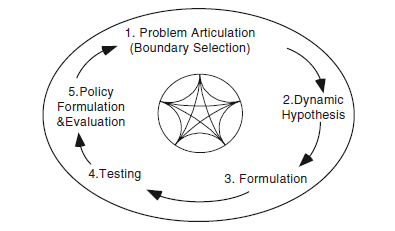Based on the feedback and requests received after publishing a blog article on systems thinking, I decided to venture into a bit more detail on systems thinking and systems dynamics and how it helps us make sense of the puzzle. In other words not only seeing the puzzle pieces but the whole picture as well (https://nikshen.com/a-systems-thinking-approach-to-solving-problems/).
Systems Thinking vs Systems Dynamics
Before we go any further it is important to understand the relationship between systems thinking and systems dynamics.
Systems thinking, like the name suggests is a way of thinking. It is when we have the mindset to approach a problem with the understanding that the problem has its own dynamic behaviour within the specific environment or system that it resides in. It focuses on considering the entire system versus just the problem in isolation which tends to be a narrow approach to solving problems. It acknowledges that the individual parts of a system will behaviour differently alone as compared to when it works in conjunction with other parts. Think of the perfect storm (the movie) in which the individual weather phenomenon’s experienced could be handled by the ship, but when they all came together, they wreaked far greater havoc.
System dynamics on the other hand is a field of knowledge or methodology to understand the complexity and impact over time of a dynamic system. Simplistically system dynamics is an approach to understand complex systems and the relationships between cause and effect with the intent of driving holistic system or business improvements. The details of the methodology will be explained further below.
Systems Dynamics (SD)
Systems thinking originated in the physical sciences where it challenged the prevailing norms by considering instability, non-linearity, discontinuity and chaotic behaviour (Mingers & White, 2010). The fundamental principle in SD states that the structure of the system gives rise to its behaviour (Sterman, 2000). This is due to the feedback loops and relationships that inherently exist between variables and within a system. SD is a discipline for seeing wholes, recognising patterns and interrelationships and learning how to structure these interrelationships in a more effective and efficient way (Huang et al, 2007). SD modelling is essentially a digital computer aided approach for mapping managers’ mental models of their system. This is converted into a simulation model to facilitate what-if experimentation. Forrester (1986) states that SD modelling is a decision-making tool to enable managers to understand the impact of their decisions in the short and long term. SD is a field that models social systems & considers the time delays of decisions and policies (Angerhofer & Angelides, 2000). The SD methodology seeks to model social systems and problems across the short, medium and long term, using inputs from the mental database as the primary input (Forrester, 1986).
SD recognizes that system behaviour is not imposed from the outside but rather from within the boundaries of the problem and that the system behaviour is a function of the interactions of the variables within the model (Richardson, 2011). Another fundamental reason for applying SD to this particular problem is that frequently one finds that individuals will follow policies, which they assume will lead to problem resolution. This is done in conjunction with the individual’s dependence on using their intuition or gut feel to determine solutions to complex behaviour (Forrester, 1994). SD helps explain the endogenous generation of macro behaviour from the myopic behaviour of individuals (Sterman, 1989).
The SD methodology
A typical methodology is the Sterman five step process. The five steps can be seen in the figure below (Sterman JD, 2000). Business Dynamics: Systems thinking and modelling for a complex world, Boston, Irwin McGraw Hill, Pg 87).

As seen in the centre of the figure (Sterman, 2000: 87), there is a network of lines joining each step to the other. This is indicative that the SD methodology is an iterative one. The intention of this is purposeful, as during the modelling process the modeler is continuously improving his/her understanding of the situation and hence the model is improved. Forrester (1986) states that the holistic understanding and building of the model is typically achieved by completing diagrams, understanding concepts, stock-flow diagrams and doing simulations which can be compared to the real world as a test. Hence as the modeler one should not expect the five steps to follow in series but rather a number of iterations of the model and steps until the problem is accurately modelled and adequately depicts reality. This must translate into the model being plausible and fit-for-purpose.
To ensure a successful project it is critical that the correct individuals be engaged. They would typically be those that play a role within the system and problem being studied and who would be able to yield the best insights (Marshall, 1996). Information collected during this process is acquired from three sources viz mental, written and numerical databases.
The steps that were followed during the development of the model are explained below:
- Step 1: Problem articulation or boundary selection seeks to identify the issue or problem within a particular environment as well as the scope of factors involved. Boundary selection is a critical step as having to narrow boundaries or scope will result in certain insights being omitted whilst having too broad boundaries results in unnecessary noise and data collection.
- Step 2: Dynamic hypothesis is the step in which the modeller would list or sketch the interactions and feedback loops of the problem which would enable a comprehensive understanding of the problem and its drivers. This aids the modeller in understanding the problem and feedback loops.
- Step 3: Formulation is the process in which the modeller transforms the hypothesis into detailed diagrams showing feedback loops and corresponding equations (Forrester, 1971). Stock-flow diagrams form a part of this step as well. Data collected was converted to quantitative inputs as required by the software used.
- Step 4: Testing simply put is the validation and verification process applied to the model built. Validation is the process followed to authenticate that the model was constructed in accordance to the prescribed methodology whilst verification is the process of comparing the models behaviour over time with evidence from the real world environment. This was done with the intent of establishing the accuracy of the model and ensuring that the model depicts reality and was fit for its intended purpose.
- Step 5: Policy formulation and evaluation is the final step and will only occur once the SD practitioner is confident that the model accurately depicts the problem and is able to simulate the real-world problem and behaviours. The SD model is then used as an improvement and learning tool to evaluate policy improvement interventions.
Conclusion
Whilst the article seeks to give an overview, note that this is but only one of the approaches used by Nikshen Consulting and is suitable and customizable for any size organisation and problem. In fact at Nikshen Consulting, we pride ourselves on ensuring we use the right tools, approach and skill set to get the job done. As a SD practitioner in the field of holistic supply chain optimisation, I cannot stress enough the importance that you look at your business as a “whole”.
Author
Dr Kenneth Moodley is an experienced supply chain and business professional with over 25 years’ experience. As someone who has applied systems dynamics and systems thinking he is well placed to support organisations on their journey. He has a demonstrated history of working with both big corporates (example: Unilever & The South African Breweries) and SMME’s (Productivity SA) in various industry sectors as a senior Supply Chain Specialist, Leader and Business Coach. In addition to his supply chain experience, he is a skilled business turnaround strategist and is a registered senior business rescue practitioner.





